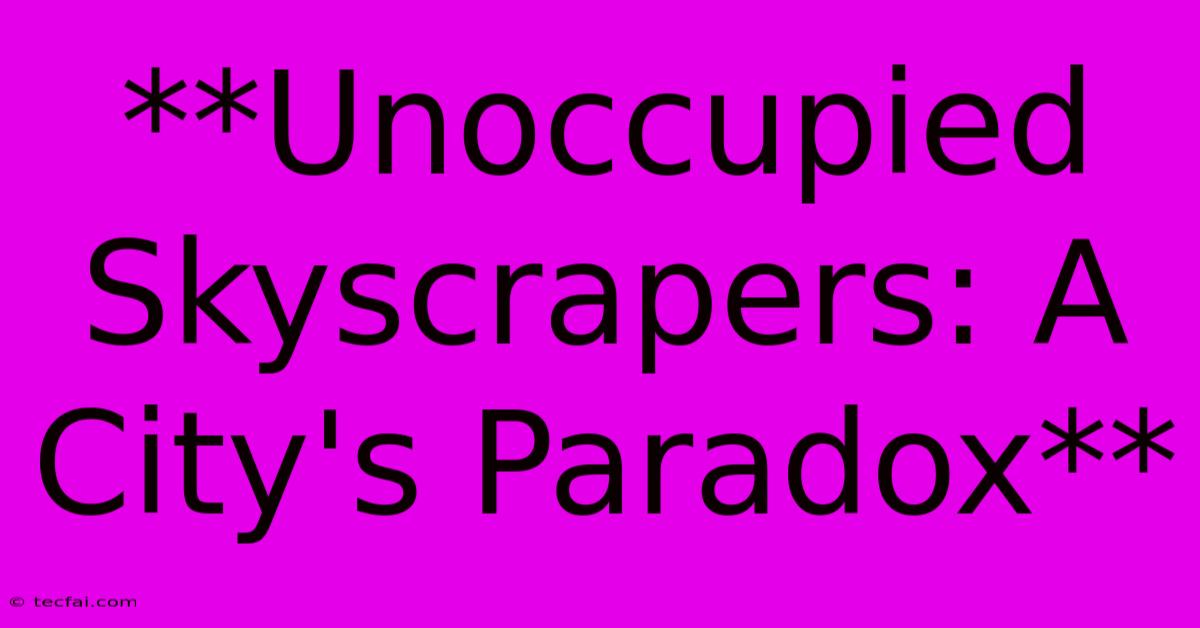**Unoccupied Skyscrapers: A City's Paradox**

Discover more detailed and exciting information on our website. Click the link below to start your adventure: Visit Best Website tecfai.com. Don't miss out!
Table of Contents
Unoccupied Skyscrapers: A City's Paradox
Towering giants against the skyline, skyscrapers symbolize ambition, progress, and the relentless march of urbanization. But what happens when these architectural behemoths become hollow shells, empty testaments to a city's changing fortunes? The phenomenon of unoccupied skyscrapers presents a stark paradox, highlighting the complexities of urban development and raising critical questions about the future of our cities.
The Rise of the Empty Giants
Several factors contribute to the rise of vacant skyscrapers. The 2008 financial crisis, for instance, left many commercial properties with dwindling occupancy rates as businesses downsized or relocated. Overbuilding in certain sectors, particularly in the wake of economic booms, can lead to a surplus of office space, creating a glut that remains unfilled.
Furthermore, the rise of remote work and changing work patterns have significantly impacted office space demand. Businesses are increasingly adopting flexible work arrangements, leading to smaller office footprints and a preference for collaborative spaces over traditional cubicle farms. These factors have accelerated the emptying of skyscrapers, leaving behind a haunting reminder of a bygone era.
The Economic and Social Implications
The existence of unoccupied skyscrapers has profound economic and social implications. Empty buildings represent lost tax revenue for cities, putting a strain on public services and infrastructure. They also contribute to a sense of urban blight, diminishing property values and creating an unwelcoming environment for residents and businesses alike.
On a social level, vacant skyscrapers can signify a disconnect between the aspirations of a city and its actual reality. They become stark reminders of economic disparities, leaving communities feeling neglected and isolated. The emptiness also creates security concerns, making these buildings attractive targets for vandalism and illegal activity.
The Quest for Renewal
Several approaches are being considered to address the problem of unoccupied skyscrapers. Some cities are implementing tax incentives and other policies to encourage adaptive reuse, transforming these buildings into affordable housing, cultural spaces, or mixed-use developments. Others are exploring innovative solutions like "vertical farming" or "green roofs," creating sustainable urban environments within these towering structures.
A Balancing Act
The phenomenon of unoccupied skyscrapers underscores the need for a balanced approach to urban development. Cities must prioritize sustainable growth, avoid overbuilding, and adapt to changing work patterns. By investing in diverse housing options, fostering a vibrant cultural scene, and creating inclusive public spaces, cities can prevent the rise of empty giants and ensure that their skylines remain symbols of hope and progress, not stagnation and neglect.

Thank you for visiting our website wich cover about **Unoccupied Skyscrapers: A City's Paradox** . We hope the information provided has been useful to you. Feel free to contact us if you have any questions or need further assistance. See you next time and dont miss to bookmark.
Featured Posts
-
Media Predictions Wrong In Us Election
Nov 06, 2024
-
How Many Teams Qualify For Champions League
Nov 06, 2024
-
Musk Sued For Election Campaign Promise
Nov 06, 2024
-
Kelce Explains Phone Spike Incident Response
Nov 06, 2024
-
Kamala Harris Addresses Crowd At Steps
Nov 06, 2024
